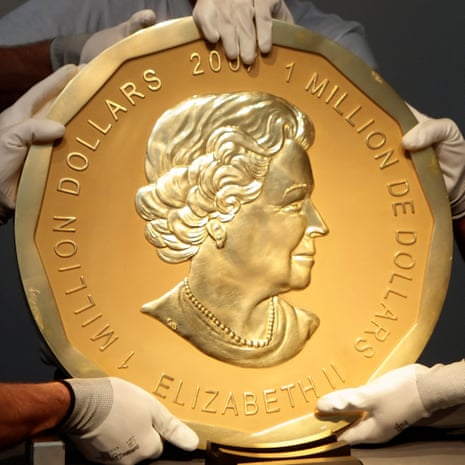Four men have gone on trial in Berlin over the spectacular theft of a giant gold coin the size of a car tire with a market value of €3.75m (£3.3m).
The men stand accused of stealing the 100kg “Big Maple Leaf” from the Bode Museum by breaking in through a second-floor window, smashing through a bulletproof cabinet, wheeling the coin through the museum on a roller board, then using a rope and wheelbarrow to transport it across rail tracks and through a park to a getaway car.
The theft in the early hours of 27 March 2017 stunned the German public, not least because of its audacity and old-fashioned simplicity, and the fact that no alarms had been triggered in the museum.
The court heard that brothers Wayci Remmo, 24, and Ahmed Remmo, 20, and their cousin Wissam Remmo, 22, allegedly executed the dramatic night-time heist with the help of a school friend who had started work as a contract security guard at the museum just weeks before the theft. The fourth suspect was identified according to German court custom as Dennis W.
If found guilty the suspects face up to 10 years in prison and will have to pay back the value of the coin.
Prosecutors assume that the coin – 53cm in diameter and 3cm thick, embossed with the head of Queen Elizabeth II and produced by the Canadian Royal Mint in 2007 – will never be recovered, having likely been broken up and melted down soon after its seizure.
Unknown perpetrators at a later stage broke into a police car park and sprayed foam from a fire extinguisher inside the getaway vehicle, possibly trying to obscure forensic traces. However, a police team discovered gold particles inside the vehicle matching the purity of the Big Maple Leaf, according to prosecutors.
A police detective who gave evidence described his surprise after being called to the museum shortly after 6am to investigate the theft of a coin, “assuming it was, well, just a coin that was missing”.
He said that on taking a closer look at the plaque next to the broken display case he discovered “that it was in fact a 100kg coin”, drawing stifled laughter from the courtroom.
Dressed predominantly in grey and black, the men, who arrived in court covering their faces from the waiting media with magazines with peepholes cut into them, spoke only to confirm their names and addresses and to describe their employment status. Three said they were either in education or apprenticeships, and one said he was working as a courier.

Judge Dorothee Prüfer noted the men’s decision to remain silent through the trial but said they could change their minds at any point, and emphasised that their decision would not alter the outcome.
Two members of the nine-strong legal team representing the men told the court they did not expect their clients to receive a fair trial, referring to the evidence against them as more circumstantial than fact based.
“Despite the huge effort in their investigations, including a special commission, 50 telephone surveillance operations and mobile phone site analysis, 30 house searches and the deployment of sniffer dogs, the evidence collected is scant” and had produced “not a single piece of drastic proof” for the complicity of any of the four in the crime, Toralf Nöding, representing Wayci Remmo, told the court.
He said the prosecution case was based mainly on anonymous tipoffs and the questionable bioforensic analysis of CCTV footage of the three brothers at a Berlin train station, which allegedly showed the suspects but not their faces.
Stefan Conen, representing Wissam Remmo, accused the media of condemning the men ahead of the trial by reporting on the family’s link to organised crime. He said as a result of the association, the police investigation had also been “one-sided”, and based on anonymous tipoffs from possible family rivals.
The trial, which is taking place in a youth chamber of Berlin’s regional court due to the fact that the men were adolescents at the time of the crime, is expected to continue until the spring.
The gold coin was marketed as the world’s largest by the Canadian Royal Mint, which said it had a face value of C$1m and could be used as legal tender.
Next up in the witness stand will be the head of security at the Bode Museum, part of Berlin’s museum island, one of the city’s biggest attractions and a Unesco world heritage site.
The museum, which has one of the world’s biggest coin collections with more than half a million objects, has come under huge pressure to explain how it was that its alarm system was not triggered on the night of the theft and why an on-duty security guard headed into the museum’s cellar precisely at the time the crime was being carried out.
